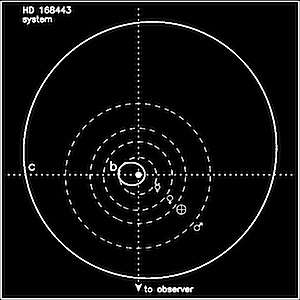Astronomers discover new planet in Pisces constellation

A team led by SF State astronomer Stephen Kane has discovered a new giant planet located in a star system within the Pisces constellation. The planet, perhaps twice the mass of Jupiter, could help researchers learn more about how extrasolar planets are formed.
The star system harboring the new planet contains only one star, as do the other three systems with extrasolar planets analyzed by Kane, an assistant professor of physics and astronomy, and his colleagues. It is a surprising finding, given the high rate of multiple-star systems in our solar neighborhood.
"There is a great interest in these stars that are known to host planets," Kane explained, since astronomers suspect that planet formation in a multi-star system would be very different from planet formation in a single-star system like our own. Kane presented his findings today at the annual conference of the American Astronomical Society.
A multiple-star system "might have not one but two planetary disks" where planets form, he said. "Or it could be that having an extra star would be disruptive, and its gravity could cause any protoplanets to pull apart."
Relatively few extrasolar planets have been found in multiple-star systems, "but we know that they are there," Kane said.
In the four systems studied by the researchers, using optical imaging data collected at the Gemini North observatory in Hawaii, there were some intriguing signs that perhaps a second star—or something else—was present.
In each system, the extrasolar planets were discovered by the radial velocity technique, pioneered at SF State by astronomer Geoffrey Marcy, now at the University of California, Berkeley. The radial velocity technique measures variations in the speed at which a star moves away and toward Earth, perturbed or "wobbled" by the gravitational pull of a nearby cosmic body. Depending on the radial velocity signature, astronomers can calculate whether the wobble is coming from a planet or star.
In the star systems studied by Kane and his colleagues, there was a part of the radial velocity data that couldn't be explained entirely by the pull of an orbiting planet. And at the same time, the planets that had already been discovered in these systems followed eccentric orbits, swinging away from their stars in a less circular and more elliptical fashion, "more like that of a comet," Kane said.
With these two clues, the researchers wondered if the radial velocity and eccentric orbits might be explained by the presence of another star in the system. But when they took a closer look at the systems, they were able to rule out the possibility that another star was perturbing the system.
"I thought we were likely to find stellar companions, and when all four didn't have a binary star, that did surprise me," Kane said.
But in the case of one star, Pisces' HD 4230, the unexplained radial velocity appears to be coming from the pull of a previously undiscovered giant planet, the researchers report. They confirmed the planet's presence with additional radial velocity data collected at Hawaii's Keck observatory.
Given that the researchers did not find any stellar companions, Kane says it is very likely that the leftover radial velocity is instead a signal that there are additional planets to be found in all four systems. The researchers feel this is especially true for the system called HD 168443, where their ability to detect a companion star was very strong.
Kane is one of the few astronomers to use a variety of planet-hunting techniques, including radial velocity and imaging. He said that the new findings had motivated him to look at other extrasolar systems with similar kinds of unexplained radial velocity data, to see if other stars or planets may be lurking there.
More information: "Limits on Stellar Companions to Exoplanet Host Stars with Eccentric Planets" is in press at Astrophysical Journal. Kane co-authored the study with SF State Postdoctoral Fellow Natalie R. Hinkel; Steve B. Howell of NASA Ames Research Center; Elliott P. Horch of Southern Connecticut State University; Ying Feng and Jason T. Wright of Pennsylvania State University; David R. Ciardi of NASA Exoplanet Science Institute; Mark E. Everett of National Optical Astronomy Observatory and Andrew W. Howard of the University of Hawaii.
Journal information: Astrophysical Journal
Provided by San Francisco State University




















